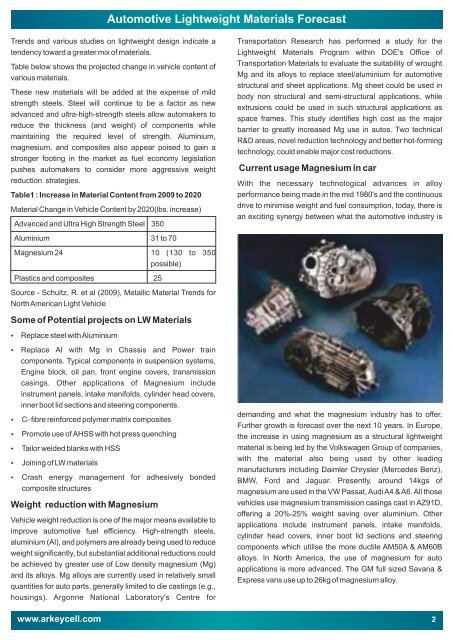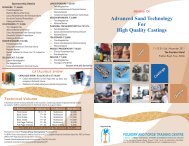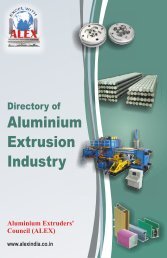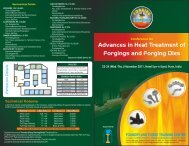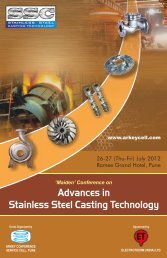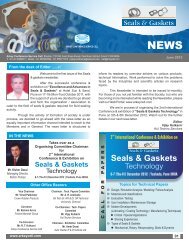LWT - Arkey Group
LWT - Arkey Group
LWT - Arkey Group
You also want an ePaper? Increase the reach of your titles
YUMPU automatically turns print PDFs into web optimized ePapers that Google loves.
Automotive Lightweight Materials Forecast<br />
Trends and various studies on lightweight design indicate a<br />
tendency toward a greater mix of materials.<br />
Table below shows the projected change in vehicle content of<br />
various materials.<br />
These new materials will be added at the expense of mild<br />
strength steels. Steel will continue to be a factor as new<br />
advanced and ultra-high-strength steels allow automakers to<br />
reduce the thickness (and weight) of components while<br />
maintaining the required level of strength. Aluminium,<br />
magnesium, and composites also appear poised to gain a<br />
stronger footing in the market as fuel economy legislation<br />
pushes automakers to consider more aggressive weight<br />
reduction strategies.<br />
Table1 : Increase in Material Content from 2009 to 2020<br />
Material Change in Vehicle Content by 2020(lbs. increase)<br />
Advanced and Ultra High Strength Steel 350<br />
Aluminium 31 to 70<br />
Magnesium 24<br />
10 (130 to 350<br />
possible)<br />
Plastics and composites 25<br />
Source - Schultz, R. et al (2009), Metallic Material Trends for<br />
North American Light Vehicle<br />
Transportation Research has performed a study for the<br />
Lightweight Materials Program within DOE's Office of<br />
Transportation Materials to evaluate the suitability of wrought<br />
Mg and its alloys to replace steel/aluminium for automotive<br />
structural and sheet applications. Mg sheet could be used in<br />
body non structural and semi-structural applications, while<br />
extrusions could be used in such structural applications as<br />
space frames. This study identifies high cost as the major<br />
barrier to greatly increased Mg use in autos. Two technical<br />
R&D areas, novel reduction technology and better hot-forming<br />
technology, could enable major cost reductions.<br />
Current usage Magnesium in car<br />
With the necessary technological advances in alloy<br />
performance being made in the mid 1980's and the continuous<br />
drive to minimise weight and fuel consumption, today, there is<br />
an exciting synergy between what the automotive industry is<br />
Some of Potential projects on LW Materials<br />
Ÿ Replace steel with Aluminium<br />
Ÿ Replace Al with Mg in Chassis and Power train<br />
components. Typical components in suspension systems,<br />
Engine block, oil pan, front engine covers, transmission<br />
casings. Other applications of Magnesium include<br />
instrument panels, intake manifolds, cylinder head covers,<br />
inner boot lid sections and steering components.<br />
Ÿ C- fibre reinforced polymer matrix composites<br />
demanding and what the magnesium industry has to offer.<br />
Further growth is forecast over the next 10 years. In Europe,<br />
Ÿ Promote use of AHSS with hot press quenching the increase in using magnesium as a structural lightweight<br />
Ÿ<br />
Ÿ<br />
Ÿ<br />
Tailor welded blanks with HSS<br />
Joining of LW materials<br />
Crash energy management for adhesively bonded<br />
composite structures<br />
Weight reduction with Magnesium<br />
Vehicle weight reduction is one of the major means available to<br />
improve automotive fuel efficiency. High-strength steels,<br />
aluminium (Al), and polymers are already being used to reduce<br />
weight significantly, but substantial additional reductions could<br />
be achieved by greater use of Low density magnesium (Mg)<br />
and its alloys. Mg alloys are currently used in relatively small<br />
quantities for auto parts, generally limited to die castings (e.g.,<br />
housings). Argonne National Laboratory's Centre for<br />
material is being led by the Volkswagen <strong>Group</strong> of companies,<br />
with the material also being used by other leading<br />
manufacturers including Daimler Chrysler (Mercedes Benz),<br />
BMW, Ford and Jaguar. Presently, around 14kgs of<br />
magnesium are used in the VW Passat, Audi A4 & A6. All those<br />
vehicles use magnesium transmission casings cast in AZ91D,<br />
offering a 20%-25% weight saving over aluminium. Other<br />
applications include instrument panels, intake manifolds,<br />
cylinder head covers, inner boot lid sections and steering<br />
components which utilise the more ductile AM50A & AM60B<br />
alloys. In North America, the use of magnesium for auto<br />
applications is more advanced. The GM full sized Savana &<br />
Express vans use up to 26kg of magnesium alloy.<br />
www.arkeycell.com 2


